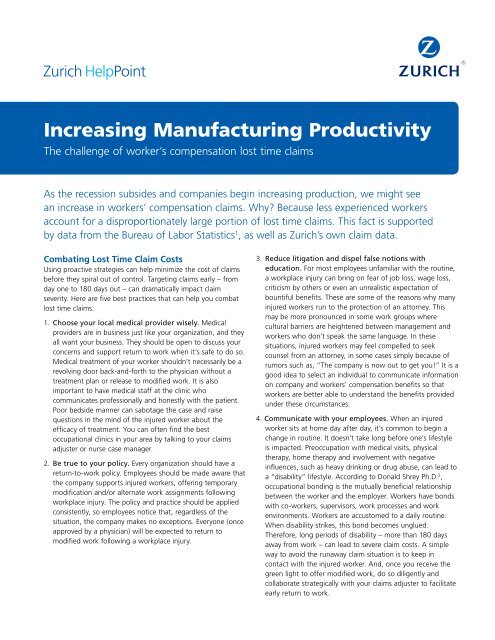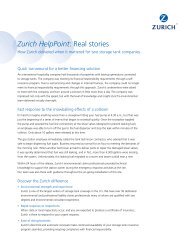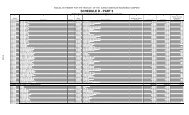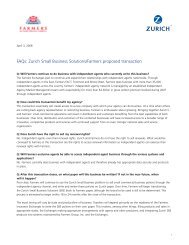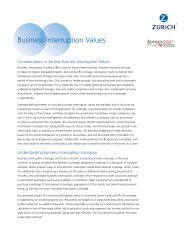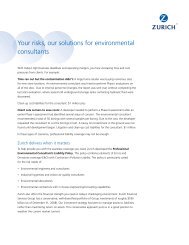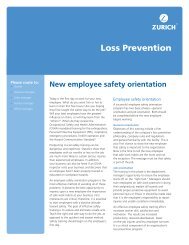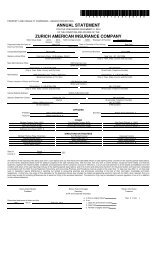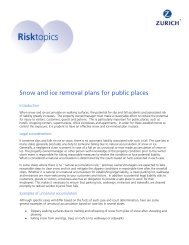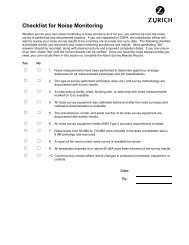Increasing Manufacturing Productivity - Zurich
Increasing Manufacturing Productivity - Zurich
Increasing Manufacturing Productivity - Zurich
- No tags were found...
Create successful ePaper yourself
Turn your PDF publications into a flip-book with our unique Google optimized e-Paper software.
<strong>Increasing</strong> <strong>Manufacturing</strong> <strong>Productivity</strong>The challenge of worker’s compensation lost time claimsAs the recession subsides and companies begin increasing production, we might seean increase in workers’ compensation claims. Why? Because less experienced workersaccount for a disproportionately large portion of lost time claims. This fact is supportedby data from the Bureau of Labor Statistics 1 , as well as <strong>Zurich</strong>’s own claim data.Combating Lost Time Claim CostsUsing proactive strategies can help minimize the cost of claimsbefore they spiral out of control. Targeting claims early – fromday one to 180 days out – can dramatically impact claimseverity. Here are five best practices that can help you combatlost time claims:1. Choose your local medical provider wisely. Medicalproviders are in business just like your organization, and theyall want your business. They should be open to discuss yourconcerns and support return to work when it’s safe to do so.Medical treatment of your worker shouldn’t necessarily be arevolving door back-and-forth to the physician without atreatment plan or release to modified work. It is alsoimportant to have medical staff at the clinic whocommunicates professionally and honestly with the patient.Poor bedside manner can sabotage the case and raisequestions in the mind of the injured worker about theefficacy of treatment. You can often find the bestoccupational clinics in your area by talking to your claimsadjuster or nurse case manager.2. Be true to your policy. Every organization should have areturn-to-work policy. Employees should be made aware thatthe company supports injured workers, offering temporarymodification and/or alternate work assignments followingworkplace injury. The policy and practice should be appliedconsistently, so employees notice that, regardless of thesituation, the company makes no exceptions. Everyone (onceapproved by a physician) will be expected to return tomodified work following a workplace injury.3. Reduce litigation and dispel false notions witheducation. For most employees unfamiliar with the routine,a workplace injury can bring on fear of job loss, wage loss,criticism by others or even an unrealistic expectation ofbountiful benefits. These are some of the reasons why manyinjured workers run to the protection of an attorney. Thismay be more pronounced in some work groups wherecultural barriers are heightened between management andworkers who don’t speak the same language. In thesesituations, injured workers may feel compelled to seekcounsel from an attorney, in some cases simply because ofrumors such as, “The company is now out to get you!” It is agood idea to select an individual to communicate informationon company and workers’ compensation benefits so thatworkers are better able to understand the benefits providedunder these circumstances.4. Communicate with your employees. When an injuredworker sits at home day after day, it’s common to begin achange in routine. It doesn’t take long before one’s lifestyleis impacted. Preoccupation with medical visits, physicaltherapy, home therapy and involvement with negativeinfluences, such as heavy drinking or drug abuse, can lead toa “disability” lifestyle. According to Donald Shrey Ph.D. 2 ,occupational bonding is the mutually beneficial relationshipbetween the worker and the employer. Workers have bondswith co-workers, supervisors, work processes and workenvironments. Workers are accustomed to a daily routine.When disability strikes, this bond becomes unglued.Therefore, long periods of disability – more than 180 daysaway from work – can lead to severe claim costs. A simpleway to avoid the runaway claim situation is to keep incontact with the injured worker. And, once you receive thegreen light to offer modified work, do so diligently andcollaborate strategically with your claims adjuster to facilitateearly return to work.
5. Establish a task bank to keep injured workers on thejob. One of the easiest ways to create light work for aninjured worker is to write down all the activities at yourplant that can be considered light or sedentary activity. Gofrom job to job asking supervisors or team leads to explainthe easiest and lightest work available in their department.Write down the physical requirement of each task, includinglifting, bending, standing, sitting, reaching, handling andmoving about. It won’t be long before you realize manyaspects of a job can be broken down into light to heavytasks. Write down the lighter tasks; these tasks will make upyour “task bank.” The list should be robust enough to keepsomeone occupied at least up to 30 days and for eighthours per day. Now that you are ready with a “task bank”in hand, you can select the appropriate work for an injuredworker. Be sure to share your “task bank” information withyour claims adjuster.1 U.S. Department of Labor, Bureau of Labor Statistics, www.bls.gov2 Shrey, Donald E. and Michel Lacerte. Principles and Practices of Disability Management inIndustry. Boca Raton, FL: CRC Press, 1997<strong>Zurich</strong> Services Corporation1400 American Lane, Schaumburg, Illinois 60196-1056800 982 5964 www.zurichna.com<strong>Zurich</strong> Services CorporationRisk EngineeringA1-20084-A (07/11) 11-1939The information in this publication was compiled by <strong>Zurich</strong> Services Corporation from sourcesbelieved to be reliable. We do not guarantee the accuracy of this information or any results andfurther assume no liability in connection with this publication, including any information, methodsor safety suggestions contained herein. Moreover, <strong>Zurich</strong> Services Corporation reminds you that thispublication cannot be assumed to contain every acceptable safety and compliance procedure orthat additional procedures might not be appropriate under the circumstances. The subject matterof this publication is not tied to any specific insurance product nor will adopting these proceduresinsure coverage under any insurance policy.©2011 <strong>Zurich</strong> Services Corporation


